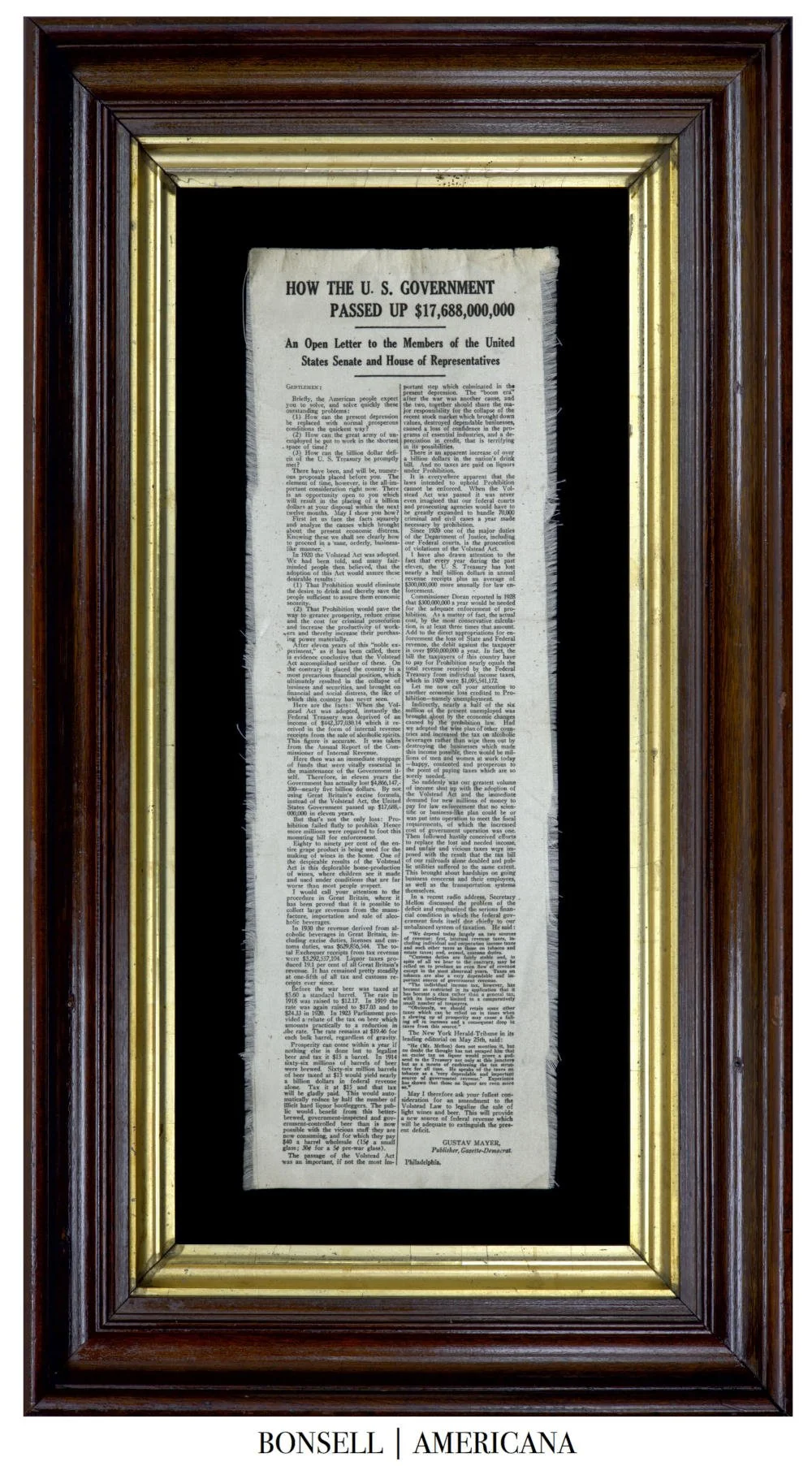Outstanding Repeal the 18th Amendment Banner | Made to Support the End of Prohibition | Circa 1932
Outstanding Repeal the 18th Amendment Banner | Made to Support the End of Prohibition | Circa 1932
Frame Size (H x L): 15.5” x 66.5”
Banner Size (H x L): 5” x 56”
Offered is an antique repeal the 18th Amendment banner, supporting the repeal of prohibition and dating to 1932. The banner is made of canvas. The field is formed via black paint, and the lettering is formed via yellow paint. The lettering states the following:
TUESDAY
AUG. 29TH
REPEAL 18TH AMENDMENT
TUESDAY
AUG. 29TH
The 18th Amendment stands out as a unique experiment in social policy. Its adoption marked the culmination of decades of activism by temperance advocates, while its repeal—barely a decade and a half later—reflected the complexities and unintended consequences of nationwide alcohol prohibition. A pivotal date in the trajectory of the 18th Amendment was August 29th, 1933, a day that signaled the amendment's impending downfall.
By the late 19th and early 20th centuries, the temperance movement had gained significant traction in the United States. Advocates believed that alcohol was the root cause of many societal ills, from domestic violence to poverty. Their activism, coupled with the moralistic fervor of the Progressive Era, resulted in the passage of the 18th Amendment in 1919. The amendment prohibited the "manufacture, sale, or transportation of intoxicating liquors" within the U.S. and its territories.
Once in effect, however, the anticipated utopia of sobriety and moral uplift failed to materialize. Instead, the nation saw a surge in organized crime, illegal speakeasies, and widespread non-compliance. Al Capone's Chicago empire, the St. Valentine's Day Massacre, and the rise of bootlegging operations became emblematic of this era. Additionally, the government lost vital tax revenue from legal alcohol sales during the Great Depression, exacerbating the nation's economic woes.
The mounting problems led many, even some former supporters of Prohibition, to reconsider the wisdom of the 18th Amendment. Calls for its repeal grew louder, and the push for the 21st Amendment—which would repeal the 18th Amendment—began in earnest.
While the official repeal of the 18th Amendment occurred on December 5th, 1933, with the ratification of the 21st Amendment, the events of August 29th were crucial. On this day, states held conventions to decide the fate of the 21st Amendment. By the day's end, 36 states had ratified it. This significant majority signaled the overwhelming desire of the American populace to bring an end to Prohibition. The ratification process would be completed later in the year, but the message from that August day was clear: The nation was ready to move on from the grand experiment of Prohibition.
The 18th Amendment represents a period in American history where national aspirations to improve society through legislative action met the complex realities of human behavior and economics. While the intentions behind Prohibition were rooted in a genuine desire to address societal problems, the real-world implications of such a sweeping policy highlighted the challenges of legislating morality. August 29th, 1933, stands as a testament to the nation's ability to recognize and correct its course when faced with the unintended consequences of its decisions.
Conservation Process: This banner was hand sewn to hemp and a mounting board. It is positioned behind Optium Museum Acrylic.
Frame: The frame has a gold outer border, a black middle border, and a gold inner border. It is lightly distressed and compliments the banner.
Condition Report: The banner has some small holes and tears. There is some flaking of both the black and yellow paint. It is age appropriate, stable, and attractive.
Collectability Level: The Great – Perfect for Rising Collectors
Date of Origin: 1932










